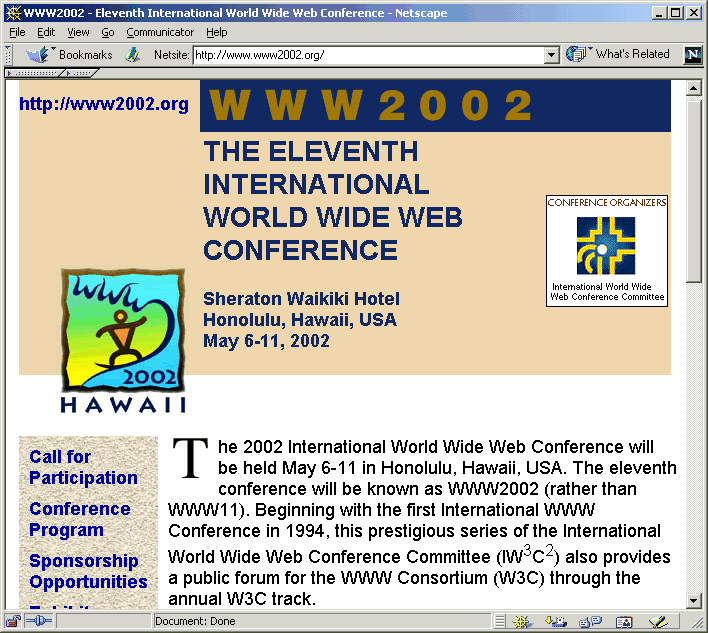Web Focus: Hot News From WWW10
Previous Web Focus articles have provided trip reports on the International World Wide Web conferences [1] [2] [3] and [4]. These reports have commented on the birth of new developments such as XML, RDF and WAP and the mobile Web. So what was hot from WWW10?
Well the weather certainly was hot - and very humid. The 1,200+ delegates were very appreciative of the air-conditioning in the Hong Kong Conference Centre, located on Hong Kong island, next to the harbour (see Figure 1).
As is the norm, a Web site [5] was provided for the conference, which contained the conference details and also access to papers presented at the conference.
What Was Hot?
A theme running through the conference was "Web services" - this phrase was featured in not only keynote speakers from software vendors and computer suppliers (such as Microsoft and IBM) but also in Tim Berners-Lee's talk on the Web.
The phrase "Web service" has been described as "an application delivered as a service that can be integrated with other Web Services using Internet standards. In other words, it's an URL-addressable resource that programmatically returns information to clients who want to use it." [6].
The role of the World Wide Web Consortium (W3C) is to facilitate the developments of Web standards and protocols to ensure that Web services will be interoperable. Tim Berners-Lee's keynote talk at the conference was entitled "Are We Done Yet?" [7]. In the talk, Tim described the architectural developments of the Web, and reviewed those architectural components which are in the process of being completed and those which are still to be developed.
Tim felt that in some respects the Web framework was complete: XML was well-established and additional XML components were being developed (XML Schemas became a W3C Recommendation on the opening day of the WWW 10 conference) and rich Web pages could now be produced using XHTML and CSS, with PNG and SVG providing powerful graphical facilities. On the other hand, a number of aspects were not yet complete: XML still requires a query language and the richer hypertext functionality of XLink and XPointer had still not been completed and work still needs to be done on the integration of Web pages with multilingual resources, the role of XSL and richer forms.
In addition to the framework for the traditional mainstream Web, additional work is still needed to support Web services. The IT community has much experience of remote operations (e.g. RPC, CORBA, etc.) Within the Web context, XML Namespaces and RDF will have to be completed in order to provide an open, interoperable framework for Web services.
The final aspect of the Web which still requires additional work is the architecture for the Semantic Web. Tim admitted that we are still at the "fun stage" - researchers are developing interesting Semantic Web applications based on RDF, but there is still little interest from the commercial community or deployment of production services. Tim pointed out that XML documents have no inherent meaning - does the content of an <TITLE> element refer to the title of a document, a CD or the status of an individual (Mr, Dr, Lord, etc.)? Once schemas become widely deployed, XML document will have meaning, which will allow software agents to be much more useful.
Tim concluded by thanking the research community for the progress so far, but reminded us that the work was not yet complete.

Figure 1: Kong Kong Conference Centre
Web Geeks Meet the Ontologists
The future of the Semantic Web was one of the main topics of discussion at the conference. Some felt that the Semantic Web was too much of an abstract research concept and that, in the light of experiences in the field of AI and Expert Systems, it would not be sensible to invest heavily in the development of Semantic Web services.
Interestingly, this conference was the one in which the knowledge representation community came along and met the Web community. This meeting of two communities was reminiscent of the initial meetings with the hypertext community - in the mid to late 1990s hypertext gurus, who previously had regarded the Web as a very flawed hypertext system, realised that, although flawed, the Web was important and would not go away. So they came to WWW conferences and engaged the Web community in discussions on W3C Working and Interest Groups. As a result of the this dialogue work progressed on the development of richer hypertext mechanisms, such as XLink and XPointer.
The same thing is happening with the Semantic Web. The Knowledge Representation community is making its presence felt through attendance at the conference (which included participation in a Semantic Web workshop, panel session and Developer's Day track), and involvement in discussion lists such as the www-rdf-interest [8] and rdf-logic [9] mailing lists. The discussions at the WWW 10 conference have generated much discussions on the lists, which can be illustrated by the responses to Jos De Roo's question "What do the ontologists want?":
Since http://www.daml.org/listarchive/joint-committee/ is public and since I'm reading them from time to time, I came across http://www.daml.org/listarchive/joint-committee/0387.html In there, I found (among other comments) [[[ It might be salutary and useful if the RDFCore were to spend some time listening to what the ontologists want, instead of telling them what they can have. ]]] Since I am a member of the RDFCore WG I'm more than glad to listen to the ontologists. So what do the ontologists want?
Over 100 responses to this thread were posted in the following 10 days!
Although the jury is still out on whether RDF and the Semantic Web will be deployed to any significant extent, it can only be good news that the ontologists and the Web communities are willing to talk to each other.
What Else of Interest
Apart from the widespread interest in Web services and the heated debates on the Semantic Web, what else was of interest at WWW 10?
Before the conference officially opened there was a day of workshops and tutorial sessions [10].
The SMIL tutorial described developments to the SMIL 2.0 specification - which hopes to become a W3C Recommendation in summer 2001. SMIL (Synchronized Multimedia Integration Language) [11] aims to provide simple TV-like "rich media"/multimedia presentations such as training courses on the Web. A SMIL presentation can be composed of streaming audio, streaming video, images, text or any other media type. SMIL would seem to be of particular interest to the teaching and learning communities as it appears to provide an open framework for developing e-learning applications.
The WebDAV tutorial described developments to the WebDAV standards. The aim of WebDAV (Web-based Distributed Authoring and Versioning) is to "define the HTTP extensions necessary to enable distributed web authoring tools to be broadly interoperable, while supporting user needs" [12].
Currently if documents can be updated by multiple authors it will be the responsibility of the authoring tool to handle file locking. If authors wish to use different authoring tools, there is clearly a problem. Management of file locking by the operating system will not provide a solution as the operating system will not be aware of the relationship of files with each other e.g. this file is the table of contents for these other files, which comprise a document which should be treated as a single object.
WebDAV aims to provide the open standard for managing distributed authoring on the Web. Support for WebDAV is available in in a number of open source systems including the Apache Web server and the Zope Content Management System. Commercial products include Adobe GoLive and Microsoft Office 2000. A list of WebDAV applications is available on the WebDAV Web site [13].
Within a University environment, in which it is unlikely that institutions will agree to adopt a single authoring tool, products which implement WebDAV would appear to be essential if distributed authoring is a requirement.
Technical Papers and Posters
The WWW10 Refereed Conference track included 78 papers. These were grouped into a number of sessions, including ETools For Learning, E-Learning Environments, Personalized Presentation, E-Commerce, XML Foundations, etc.
As well as the refereed papers track, there were also the Vendor Track, Culture Track and the Poster Track, together with the W3C Track. As will previous WWW conferences, many of the papers are available online [14] [15] [16].
The Next WWW Conference
The next WWW Conference, which has the name WWW2002, will be held in Honolulu, Hawaii from 6-11 May 2002. The conference Web site has already been set up [17]. Details of the calls for refereed papers, tutorials, workshops, etc. are available on the conference Web site. It would be good to see a significant presence from the UK - so why not think about contributing to the conference.

Figure 2: The WWW2002 Conference Home Page
References
- Report on the WWW 6 Conference, Ariadne, issue 9
http://www.ariadne.ac.uk/issue9/web-focus/ - WWW7: The Seventh International World Wide Web Conference, Ariadne, issue 15
http://www.ariadne.ac.uk/issue15/web-focus/ - Report on the WWW 8 Conference, Ariadne, issue 20
http://www.ariadne.ac.uk/issue20/web-focus/ - Reflections On WWW9, Ariadne, issue 24
http://www.ariadne.ac.uk/issue24/web-focus/ - Tenth International World Wide Web Conference,
http://www.www10.org/ - Welcome to the .NET Sample Web Services,
http://www.gotdotnet.com/playground/services/ - Are We Done Yet?, Tim Berners-Lee, W3C
http://www.w3.org/2001/Talks/0501-tbl/ - www-rdf-interest@w3.org Mail Archives, W3C
http://lists.w3.org/Archives/Public/www-rdf-interest/ - www-rdf-logic@w3.org, W3C
http://lists.w3.org/Archives/Public/www-rdf-logic/ - WWW10 Tutorials and Workshops,
http://www.www10.org/program/w10-tutwork.shtml - Synchronized Multimedia, W3C
http://www.w3.org/AudioVideo/ - DAV Frequently Asked Questions,
http://www.webdav.org/other/faq.html - WebDAV Projects,
http://www.webdav.org/projects/ - The Tenth International World Wide Web Conference & Poster Proceedings,
http://www.www10.org/cdrom/start.htm - WWW10 Vendor Track Presentations,
http://www.www10.org/vendors/ - WWW10 Web and Society Track Presentations,
http://www.www10.org/program/w10-prog-soc.html - WWW2002 - Eleventh International World Wide Web Conference,
http://www.www2002.org/
Author Details
 Brian Kelly
Brian Kelly
UK Web Focus
UKOLN
University of Bath
Bath
BA2 7AY
Email: b.kelly@ukoln.ac.uk
Brian Kelly is UK Web Focus. He works for UKOLN, which is based at the University of Bath
